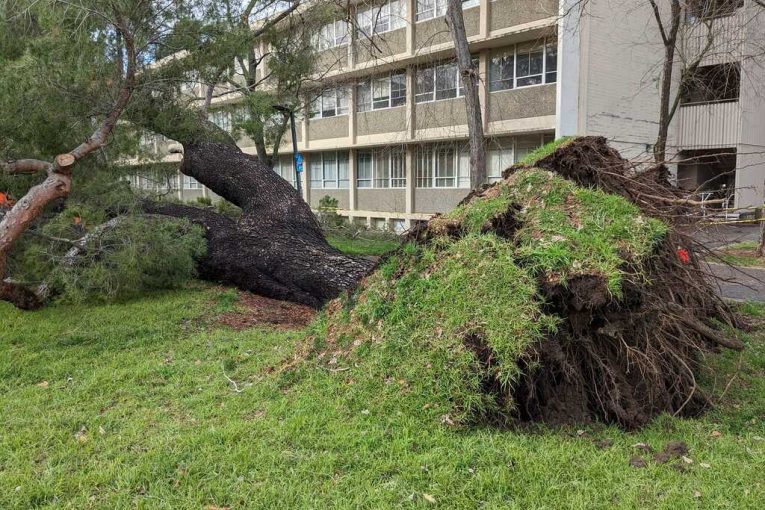
By Don Shor, John Lichter, Yael Franco, and Greg McPherson
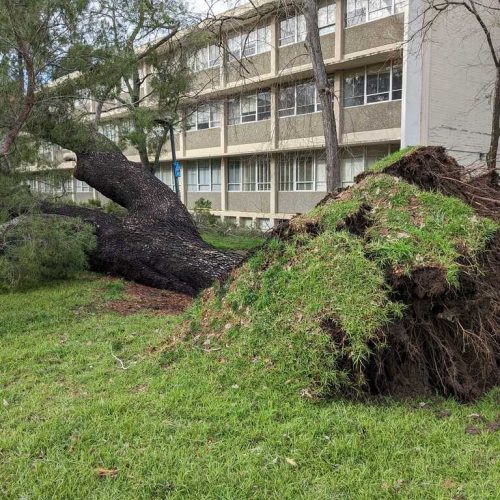
photo: pine tree toppled by wind on the UCD campus. Photo by Stu Pettygrove.
On January 8, 2023, the Sacramento region was hit by a powerful storm, one of a series of ‘atmospheric river’ events that caused widespread damage to trees. Several dozen trees went down in Davis, dozens more on campus, and the city tree staff fielded hundreds of calls for service. This has led to concerns about which trees present hazards that might become risks.
Tree failures and limb breakage in storms
Why do trees topple or experience major limb breakage in these windstorms? Why some and not others?
An important function of the root system is anchorage.
We often visualize tree roots growing much as the tops do: tender new growth emerges, grows rapidly under favorable conditions. But an important difference is that roots generally grow out much more than they grow down. The vast majority of a tree’s roots are typically in the top foot or 18 inches of soil and grow well out past the tree’s canopy.
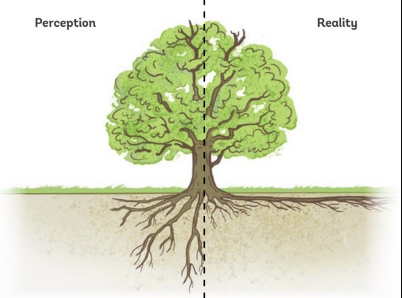
Why some and not others?
The speed and direction of wind are very important. At high enough wind speeds, and when wind comes from unusual directions, limbs and then whole trees fail, even those with the best structure. It has been a long time since we had 63 mph winds in Sacramento and that is a big reason we saw so many tree failures.
According to John Lichter, consulting arborist, “in my experience, the most common factors that cause trees to topple are high winds, root loss, and root decay. Other factors that can contribute include insufficient soil volume suitable for root growth and/or increased exposure to the wind, such as when nearby tree)s) are removed.”
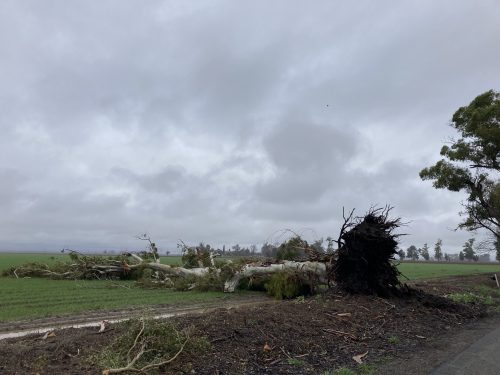
photo: Eucalyptus tree blown over next to a farm field near Dixon. Note that this tree toppled to the west, indicating wind direction from the east.
Major factors
• Irrigation frequency and distribution. Too frequent or insufficient water can affect the growth and health of the roots. Deep watering is critical to promoting deep rooting that helps anchor trees. Long and slow soakings of the soil allow moisture and roots to penetrate deeper into the soil than frequent, shallow watering.
• Improper soil preparation at the time of planting, insufficient root volume provided for the tree.
• Lichter notes root injury (from trenching, construction activity). “The loss of roots from these activities can lead to failure. When roots are wounded, over time fungal decay organisms can compromise root structure and increase the likelihood of toppling. Note that it can, obviously, be very difficult to know if a root system is compromised as it is hidden!”
• Root defects not corrected at the time of planting can cause younger trees to fail.
Species selection
There has been some discussion about whether certain types of trees had greater likelihood of failure. In the windstorm of January 8 wind speeds of 60 – 68 mph were recorded in various locations around Sacramento. From the U S Wind Climatology division of NOAA: “Damaging winds are classified as those exceeding 50-60 mph.”
Even healthy well-selected trees can be damaged by winds in that range. Generally, the crown of tall evergreen trees can act like a sail that increases pressure on the branches and roots below. Hence, evergreens (i.e., both broadleaf such as eucalyptus, and needleleaf such as pines and redwoods) tend to be more prone to failure during high winds than trees without leaves.
Limb breakage
Limb breakage is likelier in some species (ask any arborist about what types of trees they get most calls about).
• Some species have a propensity for very narrow branch angles, which often leads to included or embedded bark between the limb and trunk, weakening the branch attachment. Locust trees (Robinia pseudoacacia) are examples. When pressure in the form of excess force from wind gets applied, branches with narrow angles or included wood will predictably split, often right down into the trunk.
• Improper pruning can not only negatively impact tree structure, but it can result in a missed opportunity to improve tree structure.
o Pruning a young tree to establish a strong structure can reduce the likelihood of tree failure in the years to come.
o For mature trees, pruning is all about removing dead wood (which is prone to failure) and shortening limbs which are overextended (to reduce the force acting on them during windstorms).
o Topping or making large diameter cuts to exposed stubs typically leads to multiple, poorly attached limbs just below the cut. In addition, the large cuts are entry points for wood decay organisms which can further weaken the tree.
Trunk breakage
A tree with two or more trunks of similar size with bark embedded between the trunks are at risk of the trunks breaking apart.
Decay
Diseases can weaken branches or the main trunk. Decay, caused by fungi, can weaken the roots, trunk or limbs of a tree. The decay can be located on the exterior of these parts or internally. The impact of decay on the structure is dependent upon its location and extent.
Wind speed
• Extreme weather events can damage even healthy trees. Winds above 50 – 60 miles per hour (mph) can do significant damage to trees as well as any other objects such as roof shingles, fences, signs.
• Different types of winds do different types of damage. A strong prevailing wind with saturated soils can eventually overcome the root system’s anchoring of even a healthy tree. Short bursts of wind can snap branches, split limbs, or even break off a tree on the trunk if there is a point of weakness. Wind from unusual directions can cause damage at lower wind speeds.
What can you do?
Have your trees inspected periodically by an ISA Certified Arborist qualified to assess tree risk and pruned regularly if needed to shorten overextended branches and remove dead ones or to inspect and maintain trees if you see any of the following:.
• the tree has started to lean or an existing lean has become more pronounced and there is raised soil on the side of the trunk opposite the lean,
• there are large dead or broken branches
• there are cracks extending into the wood on the trunk(s) or major limbs,
• conks (fungal fruiting bodies which look like a half moon attached to the trunk or roots) are present,
• bark is missing or bark off the trunk or major limbs.
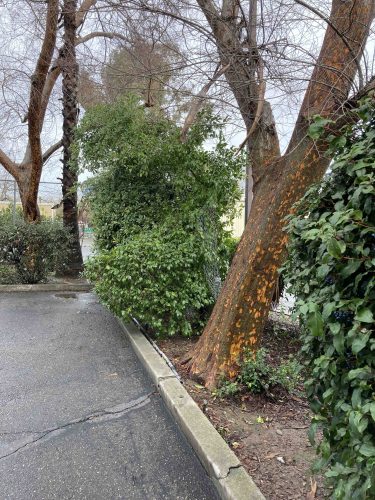 photo: Chinese elm (Ulmus parvifolia) leaning, more than it did before the storms
photo: Chinese elm (Ulmus parvifolia) leaning, more than it did before the storms
Why do palm trees rarely break off?
Palm trees have completely different anatomy of their trunks and vascular systems, and much shorter, stouter roots which can regenerate very quickly. Palm trees, like bamboo, will bend quite a bit before they will break.
Why plant and maintain trees?
We’ve known for a long time that the benefits of planting trees greatly exceed the costs of maintaining them. But recent research from a 30-year tree planting campaign in Portland, Oregon found that the number of street trees planted is associated with greater life expectancy for the people living in the neighborhoods where the trees grow. Furthermore, that association grows stronger as the trees age and grow. Yes, planting trees can save lives. And active stewardship is critical to keeping trees healthy and safe. Join Tree Davis and support our work to create the best urban forest for our community.
Don Shor is a nursery owner and member of the board of director of Tree Davis.
John Lichter is a consulting arborist and member of Tree Davis’ Technical Advisory committee.
Yael Franco is a consulting arborist and has been a program director at Tree Davis.
Greg McPherson is a retired USDA forest researcher and President of Tree Davis.





I’ve come to the conclusion that parking lots (like those at Sutter Davis) are more-appropriate places for solar panels, vs. trees.
I personally don’t want to come out and see my vehicle flattened. (Or even worse, with me in it.)
And for that matter, not right next to my home, either. I prefer having a roof in place, rather than a tree slicing the entire building in half. (And possibly me in half, as well.)
It’s bad-enough when a limb periodically falls and kills someone in a local park (e.g., Slide Hill park).
Not to mention leaves, root damage, lack of “claw” pickup, etc.
Trees “is” expensive!
Chance of death by tree is less 1/million in a given year. as far as I can tell less 150 people killed in US by trees in a given year.
But just like avoiding being eaten by a shark or hit by lightening, prudence makes sense. Don’t camp under a tree in a windstorm, for example. Or park your car under a old Modesto Ash in storm.
You can give tree healthier longer safer live if you hire an arborist to prune/shape them when they are in youth ..,, 20 year old esp 5 years old.
Pruning a young tree proactively giving them a healthy trunk and limb structure is like putting braces on a 10 year old.: The benefit is realized when that person is 40 or 60 and still has teeth.
To get a tree with good structure, it begin their 2 year in ground until <10 and < 20 years. shaped be pruned annually or every 2 or 3 years with a hand tool. cheap as can do with hand tool.. maybe a step stool and/or pole saw/clipper.
and knowledge
Sometimes, you have no choice – especially as parking becomes more scarce. Most people aren’t checking weather reports constantly, to determine where to park.
As a side note, I once had a 1948 Modesto Ash. Great car, but obviously “smoked” a lot. Never did get crushed by a tree. (Too bad that they went the way of the Edsel.)
Overall, I do think that solar panels work better for parking lots, at least. I believe they generally provide more shade (and do so immediately upon construction), create much less mess and damage to cars and parking lots, and provide energy to boot.
I’m not going to miss those relatively small trees in the Sutter Davis parking lot at all (though it’s always kind of sad to see trees cut down).
Nor would I prefer that Davis ACE’s small parking lot have trees, rather than the solar panels they installed.
I would think that (in general), the largest amount of damage that trees cause in urban environments is from roots. Which then requires “greenhouse gasses” (one way, or another) to repair.